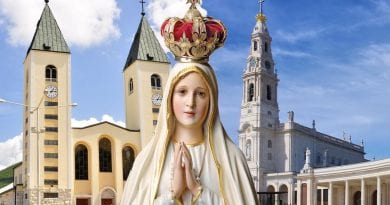The Other Famous Weeping Statue From Medjugorje
Follow Mystic Post on Facebook
THE MADONNINA OF CIVITAVECCHIA: HISTORY
It all began on September 16, 1994, when the then priest of the little church of Sant’Agostino, purchased in a shop in Medjugorie, a plaster figure representing the Holy Mary and he gave it to the Gregori family, who belonged to the parish.
The small statue was placed in a niche of the garden of the house until the afternoon of 2 February, when the phenomenon happened. Young Jessica Gregori, who was five years old at the time, saw a red liquid similar to blood falling from the eyes of the Madonnina. Scared, she ran to warn his father, who in turn called the parish priest Don Pablo to see in person the inexplicable event.
The next evening the fact happened again in front of some witnesses, and proceeded in the following days, while the number of the faithful and the curious increased. Finally on 5 February, the news was also spread by newscasts and it became a national case.

The Madonnina of Civitavecchia
Soon a heated debate broke out over the authenticity of the “miracle”, that split in two the public opinion: on the one hand the skeptics, among them was the then Bishop of Civitavecchia Bishop Girolamo Grillo who thought the event was due to human action and on the other hand believers who saw in the phenomenon a godly message.
Some among the present left their sworn testimony in front of the Theological Commission established by then Bishop Girolamo Grillo. Some radiology exams were performed but they did not reveal the presence of any weird gadget inside the statue.
There remained the suspicion that someone had soiled with a brush dipped in blood the statue and that the collective hallucination had done the rest. But on March 15, at 8.05 in the morning, an extraordinary event transformed the Bishop from skeptical into one of the most ardent supporters: the Madonnina, in fact, began suddenly to weep blod in his hands, in the presence of other witnesses.
THE MADONNINA OF CIVITAVECCHIA: SCIENTIFIC EXAMINATIONS
A first radiological analysis, carried out the February 24, 1995 at the Gemelli Hospital, ruled out the presence of contraptions or other faults inside the statue, while the folowwing 28 february the results of the examinations of the liquid removed from the statuette showed that it was male human blood.
The men of the Gregori family refused to submit to a DNA analysis to compare their profile with that of the “blood of the statue” but it must be said that one thing is the compatibility of the blood, an another is its identity. To proceed to the compatibility it could be sufficient even a limited number of polymorphisms, but it would not be enough to prove the belonging to one of the members of the family.

The Madonnina of Civitavecchia and the debate about its authenticity
In fact, in order to proceed to the identity it would have been necessary to identify a large number of elements, which was no longer possible at that moment. The analysis from the Judiciary isolated only five polymorphisms, too few for a scientifically significant comparison.
What’s more, the five isolate polymorphisms are common to the vast majority of the population and therefore any comparison would not have been totally reliable.
SKEPTICS OR BELIEVERS?
The Catholic Church has not yet expressed officially their thoughts about the weeping Madonna of Civitavecchia and still the public opinion is strongly divided between skeptics and believers.
Some voices, as confirmed by the Bishop Girolamo Grillo itself, argue that Pope Wojtyla was very devoted to the Madonnina and that more than once he went undercover to Pantano to venerate her.
From Medjugorje.hr – Official Medjugorje Parish Website
An interview with Mons. Girolamo Grillo from Civitavecchia – “The tree can be recognised by its fruits”, quotes Bishop Girolamo Grillo the words of Jesus from the Gospel, when somebody asks him about Gospa weeping tears of blood in the town of Civitavecchia. A little statue of Our Lady bought in Medjugorje more than ten years ago started to weep tears of blood about ten years ago, in the village of Pantano, near the town of Civitavecchia, 60 km from Rome.
The phenomenon was noticed for the first time on February 2, 1995. On March 15 of that same year, the bishop of Civitavecchia was personally a witness of this event, which science cannot explain. In the interview given to the Italian daily “Avvenire” (journal of the Italian Bishops Conference), bishop Grillo is evaluating what has happened in his diocese during the past ten years.
What has happened during the past ten years?
Bishop Grillo: See for yourself: since then, pilgrimages not only do not decrease, but this place of grace has been purified from all the sensationalistic elements and from curiosity. People who come to Pantano have an immense desire to change, to convert. In favour of this is also speaking the fact that I had to put five confessors permanently at the disposal of the faithful. They have told me that they have reconciled with God numberless people, people who were far from faith during long years. It has happened that they received even contrite murderers. More than thousand families, which had fallen apart because of divorce or a separated life, were reunited, and this is nowadays not a usual thing. Many women who were longing for motherhood became mothers. They continue to come here, with the desire to baptise their child precisely here. And finally, many are asking for the sacrament of baptism, even Muslims. Therefore, why not to make known all these numerous positive fruits?
Are you preparing a special initiative for the tenth anniversary?
Bishop Grillo: We have prepared a dossier, which will soon be published on national level. We have already 44 booklets with signatures of the pilgrims, with their thoughts and impressions. According to me, they reflect all the fears of our time, and at the same time hopes of those who ask for Mary’s intercession.
Any special festivities and celebrations?
Bishop Grillo: Each year in the night from February 1st to 2nd, the faithful come on pilgrimage from the centre of the town to Pantano. They walk 12 kilometres. This year, more than 1500 people were walking. They were not afraid of the freezing cold. However, let us remember: only 20 years ago, Civitavecchia was called Stalingard of Lazio. More than 60% of the population of this anticlerical and anarchistic city were communists. This event with Gospa gave a completely different mark to the city. It is true that the Mother of God was weeping, and I believe that it was not only because of Civitavecchia.
What has this event brought on the pastoral level?
Bishop Grillo: As a bishop, I am very happy that St. Augustin’ Parish in Pantano became a centre of evangelisation – not only for the whole city, but for whole Italy and for the whole world. In the last statistics for the month of November 2004, I counted twelve foreign groups of pilgrims, from Sri Lanka to Latin America. We try our best to cherish and to promote a true Marian devotion, a devotion that leads to Christ. I think that this is well accepted. For all the rest, it needs time. We have to wait and be very patient. If good fruits are not proceeding from them, supernatural events cannot be proven in a world that does not believe in God, that has lost the access to real values.
What good fruits has it brought to your personal life?
Bishop Grillo: After that morning, March 15, 1995, I was under a great chock during two or three years. The Blessed Virgin Mary has changed my life upside down, and she led me to ponder deeper into myself and into a deeper spiritual life. I have made greater efforts to be open for the needs of the faithful. Besides my pastoral work, I am consecrating additionally more time to spiritual guidance.
What is the Pope John Paul II saying about Gospa?
Bishop Grillo: During my last Ad Limina visit, Holy Father asked me about the possibility of building a Marian shrine. I answered to him that I was ready to do it, but I also asked him to help me to build in Civitavecchia a house for the sisters of Mother Teresa from Calcutta. I would really love that spiritual and material fruits of such a shrine be really and mostly of use for the poor.





